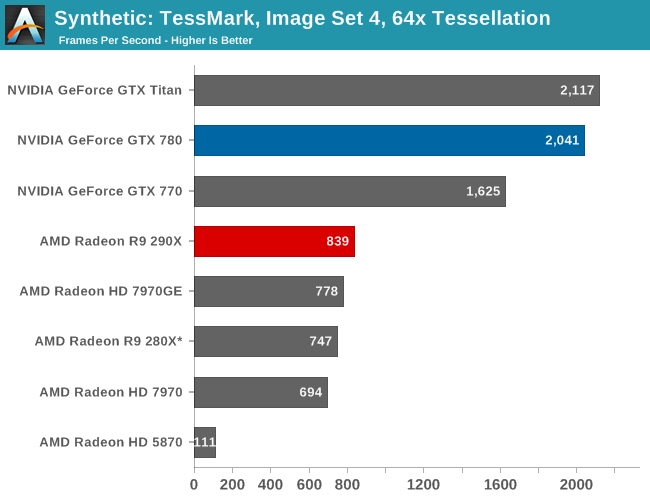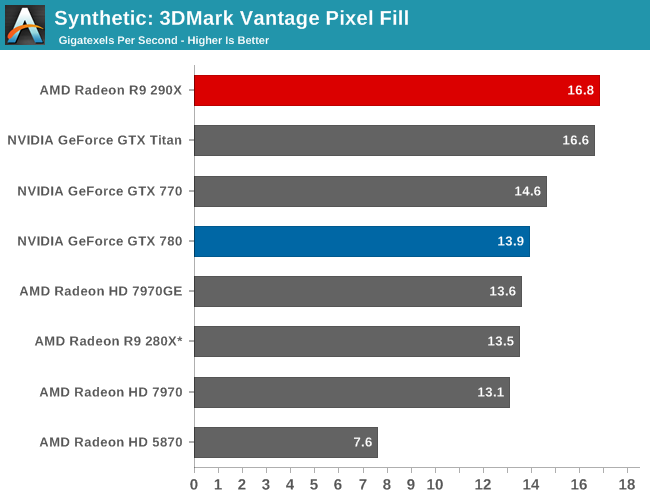The AMD Radeon R9 290X Review
by Ryan Smith on October 24, 2013 12:01 AM EST- Posted in
- GPUs
- AMD
- Radeon
- Hawaii
- Radeon 200
Synthetics
As always we’ll also take a quick look at synthetic performance. The 290X shouldn’t pack any great surprises here since it’s still GCN, and as such bound to the same general rules for efficiency, but we do have the additional geometry processors and additional ROPs to occupy our attention.

Right off the bat then, the TessMark results are something of a head scratcher. Whereas NVIDIA’s performance here has consistently scaled well with the number of SMXes, AMD’s seeing minimal scaling from those additional geometry processors on Hawaii/290X. Clearly Tessmark is striking another bottleneck on 290X beyond simple geometry throughput, though it’s not absolutely clear what that bottleneck is.
This is a tessellation-heavy benchmark as opposed to a simple massive geometry bencehmark, so we may be seeing a tessellation bottleneck rather than a geometry bottleneck, as tessellation requires its own set of heavy lifting to generate the necessary control points. The 12% performance gain is much closer to the 11% memory bandwidth gain than anything else, so it may be that the 280X and 290X are having to go off-chip to store tessellation data (we are after all using a rather extreme factor), in which case it’s a memory bandwidth bottleneck. Real world geometry performance will undoubtedly be better than this – thankfully for AMD this is the pathological tessellation case – but it does serve of a reminder of how much more tessellation performance NVIDIA is able to wring out of Kepler. Though the nearly 8x increase in tessellation performance since 5870 shows that AMD has at least gone a long way in 4 years, and considering the performance in our tessellation enabled games AMD doesn’t seem to be hurting for tessellation performance in the real world right now.
Moving on, we have our 3DMark Vantage texture and pixel fillrate tests, which present our cards with massive amounts of texturing and color blending work. These aren’t results we suggest comparing across different vendors, but they’re good for tracking improvements and changes within a single product family.

Looking first at texturing performance, we can see that texturing performance is essentially scaling 1:1 with what the theoretical numbers say it should. 36% better texturing performance over 280X is exactly in line with the increased number of texture units versus 280X, at the very least proving that 290X isn’t having any trouble feeding the increased number of texture units in this scenario.

Meanwhile for our pixel fill rates the results are a bit more in the middle, reflecting the fact that this test is a mix of ROP bottlenecking and memory bandwidth bottlenecking. Remember, AMD doubled the ROPs versus 280X, but only gave it 11% more memory bandwidth. As a result the ROPs’ ability to perform is going to depend in part on how well color compression works and what can be recycled in the L2 cache, as anything else means a trip to the VRAM and running into those lesser memory bandwidth gains. Though the 290X does get something of a secondary benefit here, which is that unlike the 280X it doesn’t have to go through a memory crossbar and any inefficiencies/overhead it may add, since the number of ROPs and memory controllers is perfectly aligned on Hawaii.










396 Comments
View All Comments
kyuu - Friday, October 25, 2013 - link
I agree. Ignore at all the complainers; it's great to have the benchmark data available without having to wait for all the rest of the article to be complete. Those who don't want anything at all until it's 100% done can always just come back later.AnotherGuy - Friday, October 25, 2013 - link
What a beastzodiacsoulmate - Friday, October 25, 2013 - link
Donno, all the geforce cards looks like sh!t in this review, and 280x/7970 290x looks like haven's god...but my 6990 7970 never really make me happier than my gtx 670 system...
well, whatever
TheJian - Friday, October 25, 2013 - link
While we have a great card here, it appears it doesn't always beat 780, and gets toppled consistently by Titan in OTHER games:http://www.techpowerup.com/reviews/AMD/R9_290X/24....
World of Warcraft (spanked again all resolutions by both 780/titan even at 5760x1080)
Splinter Cell Blacklist (smacked by 780 even, of course titan)
StarCraft 2 (by both 780/titan, even 5760x1080)
Titan adds more victories (780 also depending on res, remember 98.75% of us run 1920x1200 or less):
Skyrim (all res, titan victory at techpowerup) Ooops, 780 wins all res but 1600p also skyrim.
Assassins creed3, COD Black Ops2, Diablo3, FarCry3 (though uber ekes a victory at 1600p, reg gets beat handily in fc3, however hardocp shows 780 & titan winning apples-apples min & avg, techspot shows loss to 780/titan also in fc3)
Hardocp & guru3d both show Bioshock infinite, Crysis 3 (titan 10% faster all res) and BF3 winning on Titan. Hardocp also show in apples-apples Tombraider and MetroLL winning on titan.
http://www.guru3d.com/articles_pages/radeon_r9_290...
http://hardocp.com/article/2013/10/23/amd_radeon_r...
http://techreport.com/review/25509/amd-radeon-r9-2...
Guild wars 2 at techreport win for both 780/titan big also (both over 12%).
Also tweaktown shows lost planet 2 loss to the lowly 770, let alone 780/titan.
I guess there's a reason why most of these quite popular games are NOT tested here :)
So while it's a great card, again not overwhelming and quite the loser depending on what you play. In UBER mode as compared above I wouldn't even want the card (heat, noise, watts loser). Down it to regular and there are far more losses than I'm listing above to 780 and titan especially. Considering the overclocks from all sites, you are pretty much getting almost everything in uber mode (sites have hit 6-12% max for OCing, I think that means they'll be shipping uber as OC cards, not much more). So NV just needs to kick up 780TI which should knock out almost all 290x uber wins, and just make the wins they already have even worse, thus keeping $620-650 price. Also drop 780 to $500-550 (they do have great games now 3 AAA worth $100 or more on it).
Looking at 1080p here (a res 98.75% of us play at 1920x1200 or lower remember that), 780 does pretty well already even at anandtech. Most people playing above this have 2 cards or more. While you can jockey your settings around all day per game to play above 1920x1200, you won't be MAXING much stuff out at 1600p with any single card. It's just not going to happen until maybe 20nm (big maybe). Most of us don't have large monitors YET or 1600p+ and I'm guessing all new purchases will be looking at gsync monitors now anyway. Very few of us will fork over $550 and have the cash for a new 1440p/1600p monitor ALSO. So a good portion of us would buy this card and still be 1920x1200 or lower until we have another $550-700 for a good 1440/1600p monitor (and I say $550+ since I don't believe in these korean junk no-namers and the cheapest 1440p newegg itself sells is $550 acer). Do you have $1100 in your pocket? Making that kind of monitor investment right now I wait out Gsync no matter what. If they get it AMD compatible before 20nm maxwell hits, maybe AMD gets my money for a card. Otherwise Gsync wins hands down for NV for me. I have no interest in anything but a Gsync monitor at this point and a card that works with it.
Guru3D OC: 1075/6000
Hardwarecanucks OC: 1115/5684
Hardwareheaven OC: 1100/5500
PCPerspective OC: 1100/5000
TweakTown OC: 1065/5252
TechpowerUp OC: 1125/6300
Techspot OC: 1090/6400
Bit-tech OC: 1120/5600
Left off direct links to these sites regarding OCing but I'm sure you can all figure out how to get there (don't want post flagged as spam with too many links).
b3nzint - Friday, October 25, 2013 - link
"So NV just needs to kick up 780TI which should knock out almost all 290x uber wins, and just make the wins they already have even worse, thus keeping $620-650 price. Also drop 780 to $500-550"we're talking about titan killer here.
titan vs titan killer, at res 3840, at high or ultra :
coh2 - 30%
metro - 30%
bio - (10%) but win 3% at medium
bf3 - 15%
crysis 3 - tie
crysis - 10
totalwar - tie
hitman - 20%
grid 2 - 10%+
2816 sp, 64rop, 176tmu, 4gb 512bit. 780 or 780ti won't stand a chance. this is titan killer dude wake up. only then then we're talking CF, SLi and res 5760. But for single card i go for this titan killer. good luck with gsync, im not gave up my dell u2711 yet.
just4U - Friday, October 25, 2013 - link
Well.. you have to put this in context. Those guys gave it their editor's choice award and a overall score of 9.3 They summed it up with this.."
The real highlight of AMD's R9 290X is certainly the price. What has been rumored to cost around $700 (and got people excited at that price), will actually retail for $549! $549 is an amazing price for this card, making it the price/performance king in the high-end segment. NVIDIA's $1000 GTX Titan is completely irrelevant now, even the GTX 780 with its $625 price will be a tough sale."
theuglyman0war - Thursday, October 31, 2013 - link
the flagship gtx *80 $msrp has been $499 for every upgrade I have ever made. After waiting out the 104 fer the 110 chip only to have the insult of the previous 780 pricing meant I will be holding off to see if everything returns to normal with Maxwell. Kind of depressing when others are excited for $550? As far as I know the market still dictates pricing and my price iz $499 if AMD is offering up decent competition to keep the market healthy and respectful.ToTTenTranz - Friday, October 25, 2013 - link
How isn't this viral?nader21007 - Friday, October 25, 2013 - link
Radeon R9 290X received Tom’s Hardware’s Elite award—the first time a graphics card has received this honor. Nvidia: Why?Wiseman: Because it Outperformed a card that is nearly double it's price (your Titan).
Do you hear me Nvidia? Please don't gouge consumers again.
Viva AMD.
doggghouse - Friday, October 25, 2013 - link
I don't think the Titan was ever considered to be a gamer's card... it was more like "prosumer" card for compute. But it was also marketed to people who build EXTREME! machines for maximum OC scores. The 780 was basically the gamer's card... it has 90-95% of the Titan's gaming capability, but for only $650 (still expensive).If you want to compare the R9 290X to the Titan, I would look at the compute benchmarks. And in that, it seems to be an apples to oranges comparison... AMD and nVIDIA seem to trade blows depending on the type of compute.
Compared to the 780, the 290X pretty much beats it hands down in performance. If I hadn't already purchased a 780 last month ($595 yay), I would consider the 290X... though I'd definitely wait for 3rd party cards with better heat solutions. A stock card on "Uber" setting is simply way too hot, and too loud!